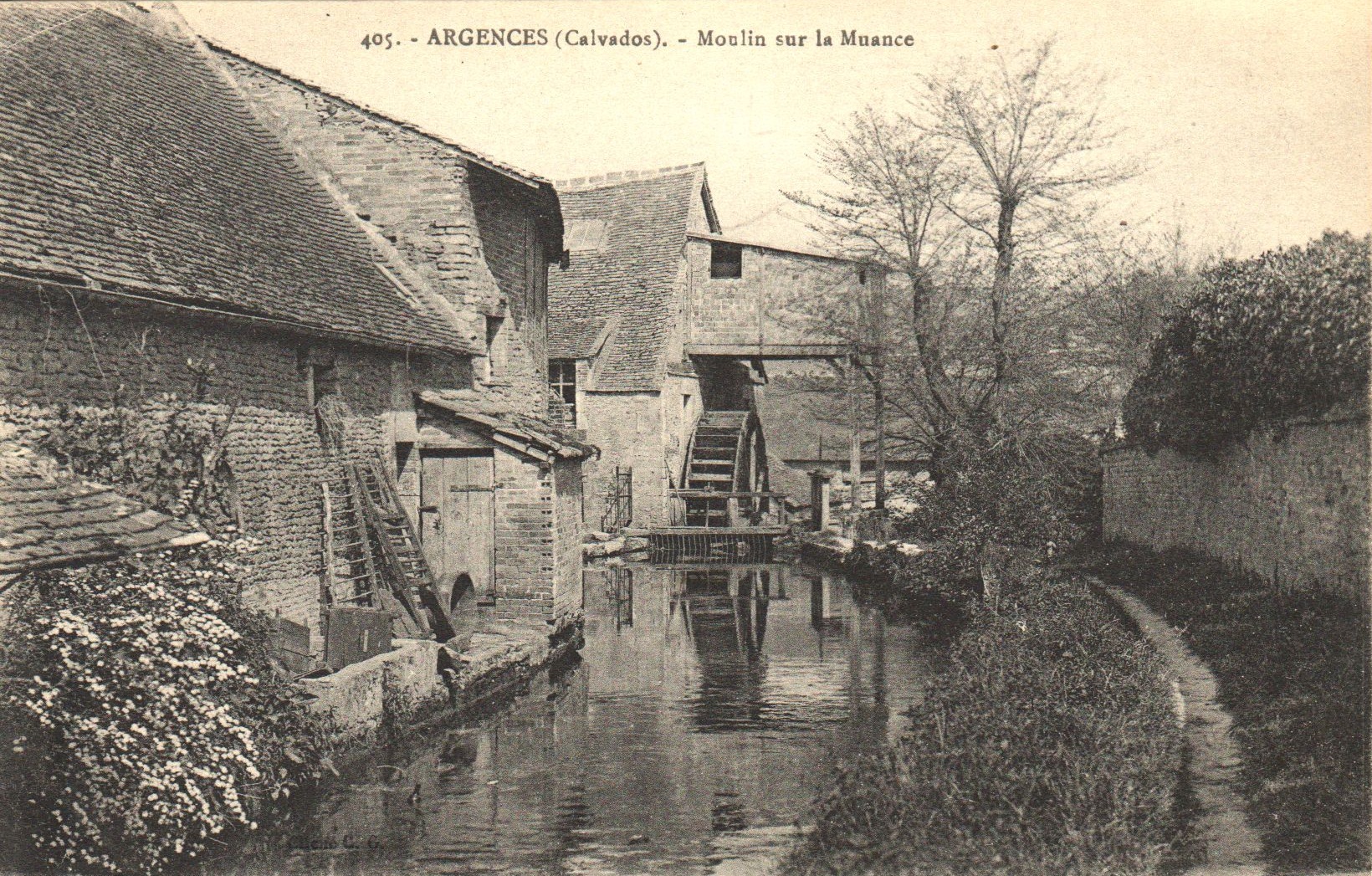History
The Moulin de la Porte was built between 990 and 1025.
In 990 Richard I, Duke of Normandy (942-996) gave Argences to the Abbey of Fécamp „Argentias cum appenditis suis“. The first quotation found of the town’s name. (Bib n°11)
In 1001 William of Volpiano (962-1031), a famous Benedictine reformer, was called by Duke Richard II to run the Abbey of Fécamp. Perhaps it was he, for economic reasons, who decided to develop the fiefdom of Argences in order to give his community a substantial income by having water mills built. A large number of them were then created in Normandy. They responded to the new needs of a prosperous agricultural economy.
In 1025 Richard II, Duke of Normandy (996-1026) confirmed his father’s donation; the charter specifies “Argences with the church, the cultivated and uncultivated land, the meadows, the vines, the woods, the mills, the waters and watercourses“ (Cf “Au fil de la Muance n°1”) (Bib n°11)
The Lord Abbot of Fécamp created here a coherent and complementary economic and religious complex made up of the cereal production of the Caen plain, the market, the mills, the common ovens, the large wheat markets in the centre of the town and the small grain markets (site of the current town hall); a priory inhabited by the monks until 1440, their chapel of St Jean, adjoining the moulin de la Porte. The latter thus belongs to the first creation, its creation is prior to 1025.
The channelled Muance and the „banal“ mills.
The reports of the water engineers, delegated by the Prefects to „regulate“ the mills in the 19th century, specify that the course of the Muance, a tributary of the Dives, feeding the mills, was diverted from its natural bed about 500 metres before the Vérignier (between Moult and Argences), as far as beyond the mills of the Fresne d’Argences. At this level the riverbed is well above the valley bottom. Originally, the Muance was supposed to flow through low marshy fields in the process of sedimentation, these works have fixed it. The Morte-Eau partly occupies the natural valley floor and drains it through several ditches. Through a sluice gate, belonging to the Moulin de la Porte, it can be used to divert the Muance. The bottom of the Moulin de la Porte mill is paved over several metres No text specifies the exact date of this work – but only a rich abbey had the financial and technical means to carry it out. Their importance demanded a high level of profitability.
The four ordinary mills belonging to the abbey of Fécamp were the mill of the Fountain, known as the barley mill, the mill of the Gate and the two adjoining mills of the Fresne, one for barley, which has now completely disappeared, and the other for wheat, whose building, rebuilt in the 19th century, still stands at the exit of the village.
Excerpt from the magazine n°9 “ Au fil de la Muance “ of February 2007 by Ch. LECHEVALIER and A. LIVET.
After the Revolution of 1789:
The moulin de la Porte, which had become a national asset, was bought by Sieur Planquette de Falaise in 1793,
The same owner acquired the moulin de la Fontaine.
His successor, Ozouf, husband of the widow Planquette, raised the banks of the river to make it bigger. the fall, but heavy rains during the winter of 1805/1806 caused the flooding of the town and generated crossing the ford, route de Troarn. Sieur Ozouf had to have the first bridge built there.
At the same time, 1793, the construction of a new mill, at the corner of Rue Morte Eau by Cailloué,
mayor of Argences, led to multiple lawsuits from other millers. The multiplication
turns“ held back the current and disturbed the water levels. In 1863, the Prefect imposed regulations
and water level to all.
The 19th century
It is the great age of the mill. The increase in demand for baking flours and cereals for livestock breeding develops to the maximum these traditional industries using natural energy such as steam has not yet been replaced.
In 1807, 3 wheat mills were built in Argences, each with 2 „tournants“, 3 in Le Fresne, equipped with 5 „turners“ and 1 paper mill, the Cailloué mill.
In 1821, Sieur Bellemare, husband of Miss Planquette, requested the construction of a 3rd “turn“ at the mill of the Gate: 1 against the wall and 1 in a converted conduit. This transformation led to the extension of the building towards the garden. This is its current architectural conformity.
In 1890, the moulin de la Porte had only 2 „turns“ left and became the Dalgot property. Then G. Saulnier bought it in 1910, a single „turn“ animates 2 pairs of millstones. At that time the Wisteria still blooming in front of the mill. In 1904, a 10-year-old child, the young Badet, died in falling into the wheel. Mr. Derniaux bought the mill in 1934. During the last war, the people of Argentia were going to make Some people used to grind wheat and some ate good white bread (see “Au fil de la Muance“ n° 2).
In 1949, Mr. Sicot, the last miller, replaced the wheel with a „Francis“ type water turbine that drives the 2 pairs of millstones.
This is the current mechanism… The flour mills imposed themselves, but the mill continued to turn while diversifying… its productions: barley and flattening of maize, broad beans… It worked until the years 1980…Madame Derniaux died in 1996. Mr Sicot died in 1998. The commune bought the mill in 1999 and is working to safeguard it. Our association, created in 2000, is in charge of its maintenance and animation.
The moulin de la Porte in the 1900s



